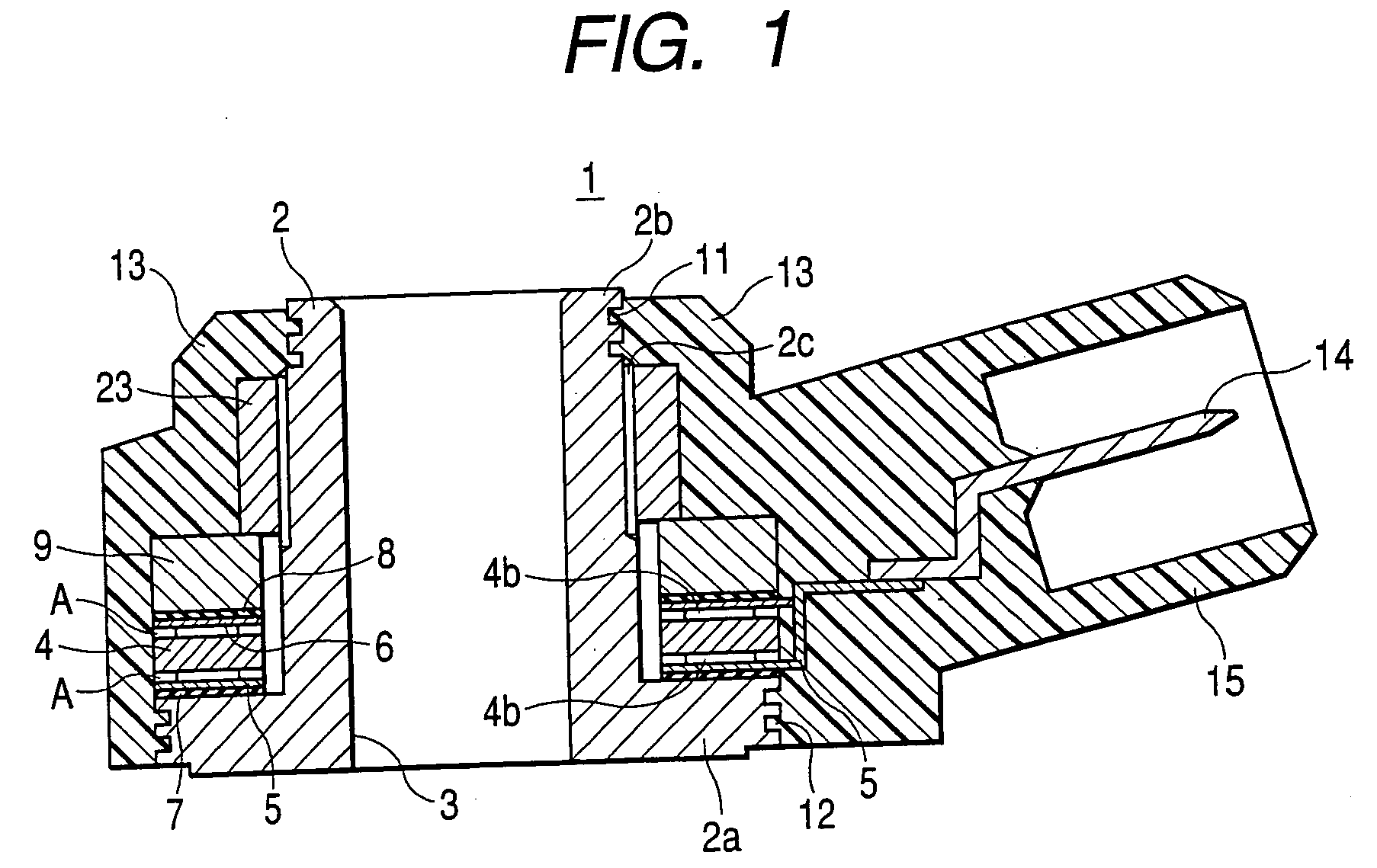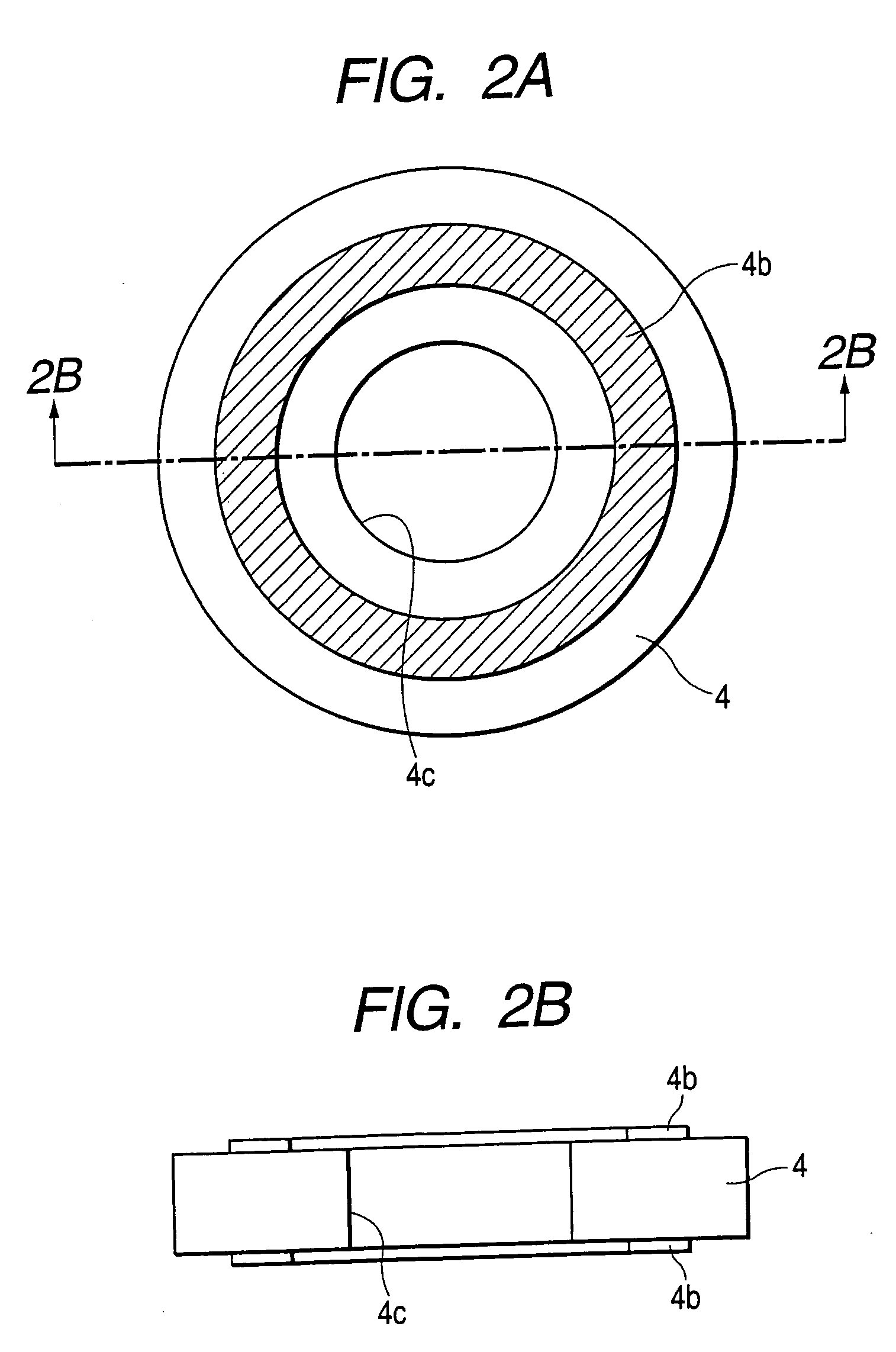Knock sensor
a technology of knock sensor and output, which is applied in the direction of acceleration measurement using interia force, machines/engines, instruments, etc., can solve the problem of superimposed noise on the output of the knock sensor, and achieve the effect of stable output and changeable electrostatic capacity of the piezoelectric elemen
- Summary
- Abstract
- Description
- Claims
- Application Information
AI Technical Summary
Benefits of technology
Problems solved by technology
Method used
Image
Examples
embodiment 1
[0024] Hereinafter, embodiment 1 of this invention will be described with reference to the drawings.
[0025]FIG. 1 is a sectional view showing an inner structure of a knock sensor of embodiment 1 of this invention.
[0026] The knock sensor 1 is constructed such that all component parts are covered with a case 13 made of synthetic resin (for example, nylon 66), and a connector part 15 for connection with a connector from an ignition timing control device (not shown) is formed on the case 13.
[0027] A base 2 is made of metal, and is constructed of a cylindrical part 2b having a through hole 3 and a disk-like flange part 2a provided at its one end. Plural engagement grooves 11 and 12 for ensuring engagement with the case 13 and preventing intrusion of water from the outside are formed on the outer peripheral surface of the flange part 2a and the tip end (upper end in the drawing) outer peripheral surface of the cylindrical part 2b. An annular piezoelectric element 4 is slid onto a portio...
embodiment 2
[0038] Next, embodiment 2 of this invention will be described with reference to the drawings.
[0039]FIG. 3 is a sectional view showing an inner structure of a knock sensor 20 of embodiment 2 of the invention.
[0040] Although embodiment 2 has the same structure as embodiment 1, a conductive adhesive B is filled in a gap existing between an electrodeless part of an electrode formation surface of a piezoelectric element 4 and terminal plates 5 and 6 and corresponding to the thickness of a partial electrode 4b of the piezoelectric element 4. As the conductive adhesive B, an epoxy adhesive containing conductive metal powder is suitable.
[0041] In order to apply the conductive adhesive B to the electrode formation surface of the piezoelectric element 4, there is a method in which the piezoelectric element 4 is rotated under a discharge port of a dispenser for discharging a predetermined material, and a uniform coat is applied to a predetermined coated surface, or a method in which the pie...
embodiment 3
[0047] Next, embodiment 3 of this invention will be described with reference to the drawings. FIG. 4 is a sectional view showing a structure of embodiment 3. In a knock sensor of embodiment 3, a gap existing between an electrodeless part of an electrode formation surface of a piezoelectric element 4 and terminal plates 5 and 6 and corresponding to the thickness of a partial electrode 4b of the piezoelectric element 4 is filled with an electric insulating material C containing a filler having a particle size smaller than the gap. Since the other structure is the same as embodiment 1, its description will be omitted. As a manufacturing method, manufacture can be made by the same manufacturing method as embodiment 1. However, since the filler in the electric insulating material C is dispersed without being collapsed in the gap, the material can be filled in the gap without damaging the physical properties of the electric insulating material C.
PUM
| Property | Measurement | Unit |
|---|---|---|
| pressure | aaaaa | aaaaa |
| thickness | aaaaa | aaaaa |
| weight | aaaaa | aaaaa |
Abstract
Description
Claims
Application Information
 Login to View More
Login to View More - R&D
- Intellectual Property
- Life Sciences
- Materials
- Tech Scout
- Unparalleled Data Quality
- Higher Quality Content
- 60% Fewer Hallucinations
Browse by: Latest US Patents, China's latest patents, Technical Efficacy Thesaurus, Application Domain, Technology Topic, Popular Technical Reports.
© 2025 PatSnap. All rights reserved.Legal|Privacy policy|Modern Slavery Act Transparency Statement|Sitemap|About US| Contact US: help@patsnap.com



